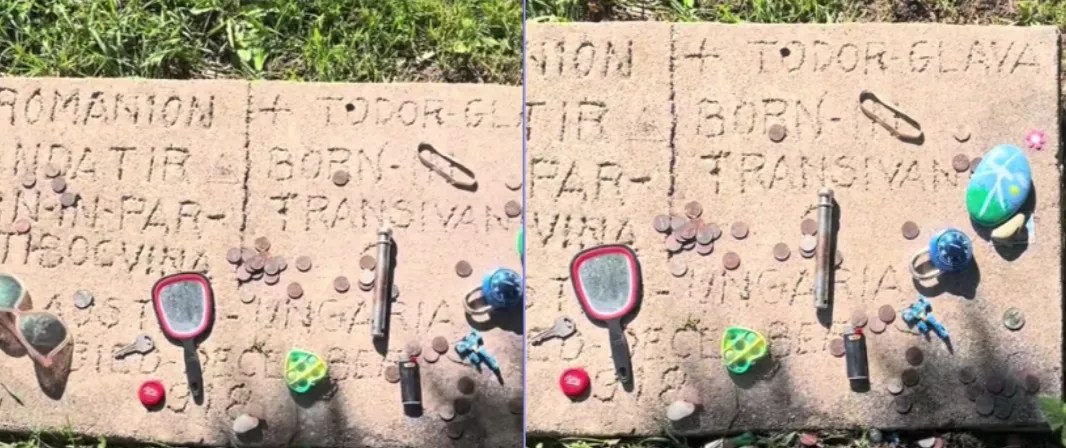
Screenshots from @thefolklord on TikTok

Audio By Carbonatix
A vampire lies in the Lafayette Cemetery on Baseline Road – that is, if you believe the local lore.
Theodore Glava, who was born in Transylvania and moved to Lafayette as a coal miner in the early 1910s, makes his final resting place in the Colorado city’s municipal cemetery under an unassuming headstone beside a tall, straight tree.
As the legend goes, the tree grew from the stake townspeople drove into Glava’s heart to be sure he was truly dead, while the rose bushes nearby grew from his fingernails. If you go to the graveyard at midnight on Halloween – which is illegal and not recommended – you just might see the shadowy figure of Glava himself hunched over his grave. People have also reported numerous signals of apparitions: electronics losing battery much more quickly than normal and spooky voices near Glava’s grave.
In reality, though, Glava was (probably) not a vampire; that rumor only began in the 1960s.
Will you step up to support Westword this year?
At Westword, we’re small and scrappy — and we make the most of every dollar from our supporters. Right now, we’re $21,000 away from reaching our December 31 goal of $50,000. If you’ve ever learned something new, stayed informed, or felt more connected because of Westword, now’s the time to give back.
“For people in Lafayette, it’s a fun [legend] to have about the city where you live and your hometown,” says Chelsea Pennington Hahn, director of the Lafayette History Museum. “People outside of Lafayette take it more seriously. We have people who will travel here and leave gifts at the grave.”
Glava’s grave is often covered in curios such as coins and small charms as tributes to the alleged vampire. Pennington Hahn notes that it is unusual that Glava would have a headstone in the part of the cemetery known as the potters’ field, though, which is where those who couldn’t afford a burial were placed.
“You don’t really get a headstone – maybe a wooden cross, but nothing really permanent,” she says. “Yet there is a cement slab in that area that dates from when there should not have been any gravestones. So it’s a little weird that there’s a cement slab where no one else would have gotten a permanent grave marker like that.”
That weirdness, along with Glava’s birthplace, likely contributed to the urban legend, Pennington Hahn suggests. The region of Transylvania, which is near Romania in Eastern Europe, has ties to vampires thanks to Bram Stoker’s Dracula. “Transylvania” is inscribed on Glava’s grave as his birthplace.
Historic records don’t show an uproar over Glava’s possible vampirism at the time of his death, so the running theory among local historians is that the myth took off when vampires re-entered trendy culture in the 1960s and 1970s.
Glava died in 1918, so he was most likely a victim of the Spanish Flu, Pennington Hahn says. Though records show Glava had a cousin eventually join him in Lafayette, he didn’t have much, if any, family left behind after his death. That also contributes to how his grave could become the subject of a myth.
“If he had family or people here, they would remember him,” Pennington Hahn points out. “If a rumor started about, ‘Oh, this guy was a vampire’…about my grandpa, or even great-grandpa, I’d be like, ‘No, that’s crazy. What are you talking about?’ But there was no one for that for Glava.”
Because of the Spanish Flu, xenophobia was aimed at people from Eastern Europe and the Austro-Hungarian Empire at the time of Glava’s death, she adds, so he may have been seen as an outsider even during his life (there’s no evidence to suggest he was actively persecuted as a vampire).
Another oddity is that Glava shares his headstone with another man, whose name is inscribed on the left side of the headstone. No rumors have ever started about that person being a vampire, and Pennington Hahn says the biggest remaining questions about Glava surround who that neighbor is, and why the pair received a dual headstone.
What is definitely false about Glava is the idea that townspeople dug his body up after he was buried because of their suspicions. One legend says that Glava was even staked through the heart before his death because of his vampiric extracurriculars.
But the more popular lore postulates that after his death, those in the area exhumed his body – just in case. The lore says that when he was dug up, his teeth were huge, his mouth was bloody and his nails had continued to grow. Those are all natural signs of a decaying body, but the townspeople found it as evidence of a vampire and staked Glava through the heart to ensure he stayed in the grave.
According to Pennington Hahn, there is no city record indicating that anyone was authorized to dig Glava back up.
“It’s theoretically possible someone dug it up,” Pennington Hahn says. “But that also would be pretty obvious, because there would be a fresh mound. I think that would have made newspapers, and I have not read anything like that.” Plus, grave robbing was an illicit activity – though the public often turned a blind eye – that was most popular during the antebellum period, before Glava’s death.
Pennington Hahn says there are people still alive in Lafayette today who know those who started the vampire rumor, so she expects the myth will need to persist for another sixty years or so to become a true piece of local lore.
While spooky adventurers can visit the gravestone during the day, the cemetery is still active, so guests are asked to be respectful.